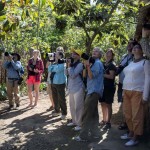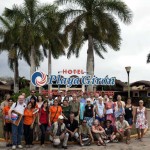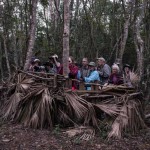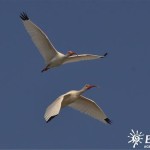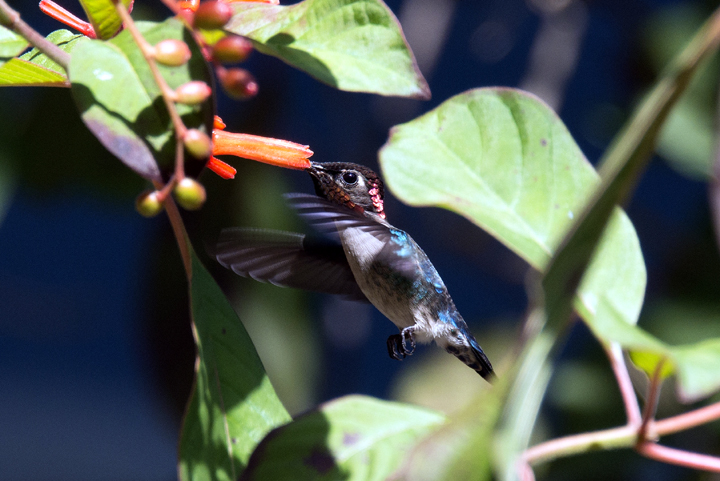
Americans, Russians and Cubans point to the sky
CIÉNAGA DE ZAPATA, Cuba, Feb. 23, 2015 — Three men walk on the sand, each one in search of his prey, each one eager to win. A Russian, an American and a Cuban. Their weapons are modern still cameras with impressive telephoto lenses. At times, we hear the furious burst of shutters; between shots, they exchange mischievous grins.
The men are part of a group of photographers who compete in the contest Photos on the Go 2015, held at the Ciénaga de Zapata [the Zapata Swamp], a place in Matanzas province where the boundaries between past and present seem to vanish.
The battle debris that still remains evoke those intense days of the invasion through the Bay of Pigs, the popular mobilization, the victory over Brigade 2506 on April 19, 1961. It is the same area toured, more than five decades later, by 12 Russians, 10 Americans, 5 Cubans and some Argentines and Canadians.
Photography is their common language. They are joined by their love of nature. The images speak for themselves of the ecological richness of the region.
An exuberant surrounding characterized by the high degree of endemism of its species, together with beautiful beaches and well-conserved marine depths, the nearness to Havana and easy access by road make this southern-coast peninsula an extremely attractive destination for people interested in hiking, ecotourism and other forms of that type of activity, which, in the past two years, has shown a sustained increase.
Fortunately, the birds need no passport, visas or licenses to enter or depart from Cuba, nor do they need hotels or tourist sites. For the past several hundred years, in winter, they come to this warm and fertile land from the north and return in spring.
From the cold Ithaca, N.Y., site of the world-renowned Cornell University’s ornithology lab, come the passerine woodpecker and the red-throated hummingbird. From other places arrive birds of prey by the thousands, white and brown pelicans and uncounted birds from all of North America. There is food and warmth for all of them.
It could be said that nature has managed to contribute to the rapprochement between two nations separated by a political conflict for more than 50 years.
Specifically, for the past 10 years, specialists from Cornell and other universities have been in contact with Cuban scientists, sharing experiences and knowledge, expressing surprise at the endemic Cuban birds, among them the zunzuncito [bee hummingbird], the world’s smallest bird.
For many in Russia, beginning with the collapse of socialism and the disappearance of the Soviet Union, their links with Cuba weakened with time, until they became in some cases like frozen memories of an ever-farther past.
On the island, the footprints of that almost-four-decade relation still remain. Left behind were the Lada cars and the Zil trucks that still roll on streets and fields, as well as the rigorous training of many of the island’s scientists. The children of Cuban men and Soviet women, with hard-to-pronounce names, can be met on the streets of any city.
There’s the matrioshkas, the Wolf and Hare cartoons, the Andrei Tarkovsky films, Alicia Alonso and Vladimir Vasiliev dancing “Giselle.” In the Russian mind, Cuba was the promised land, a warm and beautiful place with beaches and coconut trees where they were always treated as brothers. Today they return with the same customs and the desire to reestablish relations.
Russians, Americans, Cubans, all with their own stories, expectations and hopes that bring them together in this unique photo contest sponsored by the Ecotur Travel Agency, are taking advantage of an intense program that transcends the act of pressing a button in a camera.
Their visit to the Playa Girón Museum shows them the living conditions in the region before 1959. It is a perfect opportunity to understand the background to the combat that took place in the area between April 17 and 21, 1961.
The photographs made at that time show the rawness of the confrontation, the uncertainty of the vanquished, the joy of the militiamen, and the faces of the fallen. Russian mortars against U.S. machine guns.
Returning to the present, a meeting with the residents of the Los Hondones hamlet allows them to see how the Cenagueros live today. In most of the peninsula, thanks to the arrival of international tourism, living conditions have improved notably.
CIÉNAGA DE ZAPATA, Feb. 27 — The contest ends. After several hours of debate, the international jury has selected the best pictures. Then comes the awards ceremony. Although all contestants are adults — some of them elderly — their nervousness is evident.
Each result is greeted with heavy applause, while a screen shows the rewarded image. Yekaterina Papchinskaya and Charles Edward Steward win two of the categories.
The expectation reaches its climax. The Grand Prize goes to … Ernesto Reyes Mouriño, whose face lights up as he barely can hold the many diplomas and gifts he has received.
Before parting, and after being invited to next year’s contest, they all share a delicious Cuban-style luncheon on the shore, by the same sea that separated them for so many years but never prevented the coming and going of the birds.





